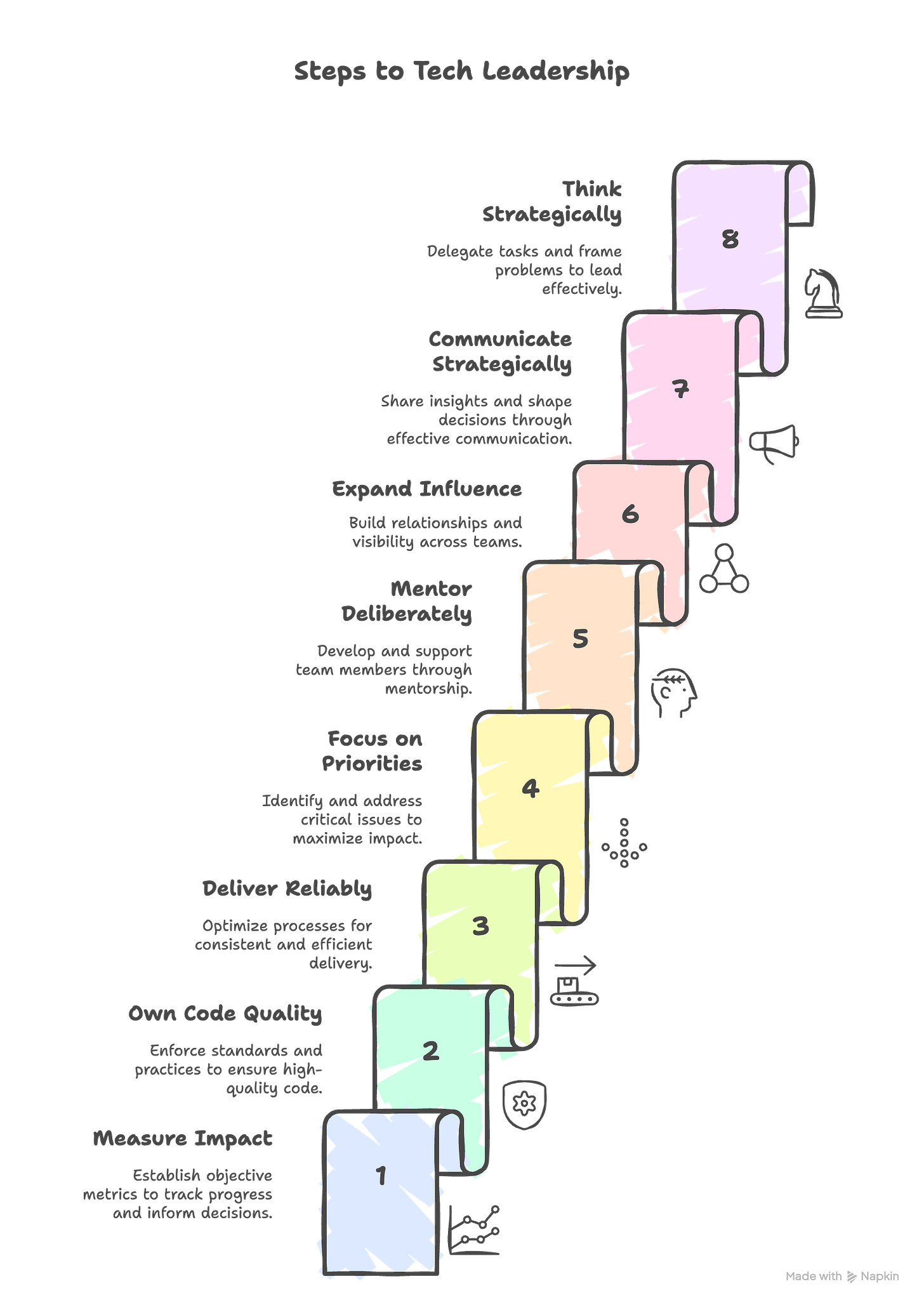The Concrete Path to Tech Leadership
Focused, measurable practices for senior engineers aiming for staff engineer or tech lead responsibilities
You will love this edition… and you know it.
If you’re a Senior Software Engineer or an early Tech Lead aiming for Staff Engineer/leadership, stop treating growth as a mystery.
Combine day-to-day craft with deliberate influence:
Measure what matters.
Lead by example.
Make others better.
Below, I wrote for you 8 condensed and high-impact keys to make you thrive to the Tech Lead and Staff Engineer roles.
Seems interesting to someone else? Share it with your friends via 👇🏻
1) Measure your impact
👉🏼 Make it objective.
Pick 3–4 metrics that reflect your scope. Some suggestions:
Cycle time.
Number of incidents.
Percentage of planned technical work delivered.
Review them weekly and bring them to 1:1s. Metrics make conversations about promotion factual, not fuzzy.
🧭 Signal: You can show progress with hard data, and your manager uses your metrics as input for performance reviews.
2) Own code quality and maintainability
👉🏼 You are accountable for it.
Enforce review standards, pair program on risky changes, and add simple quality gates (linters, small architectural checklists).
🧭 Signal: Sustained reduction in bugs and PR rework; teammates copy your review habits.
3) Deliver reliably
👉🏼 Optimize the delivery pipeline.
Remove bottlenecks (CI flakiness, slow deploys). Practice small, reversible changes and a clear rollback plan.
🧭 Signal: More frequent, low-risk releases and faster mean-time-to-recover.
4) Focus on the right priority
👉🏼 Your time is precious, focus on solving the right problem.
Solve tech debt, bug reduction, help in support or on-call duties, cost reduction, improve delivery of the infrastructure for dev teams, or architecture simplification… Pay attention to what hurts engineering management, or ask directly, and focus your efforts on solving that.
🧭 Signal: Engineering management will see you as a committed person who focuses on the right things.
5) Mentor deliberately
👉🏼 Healthily multiply your time.
Run focused mentoring (pairing, shadowing, learning paths). Give teammates stretch assignments and public credit.
🧭 Signal: Measurable promotion/upskilling of peers and fewer repeated mistakes.
6) Expand influence beyond your team
👉🏼 Make yourself visible.
Build relationships with product, infra, and other engineering teams. Attend cross-team demos, volunteer for integrations, and learn key business metrics. Influence is the difference between a good engineer and an obvious leader.
🧭 Signal: Stakeholders outside your team seek your input, the go-to person, before making technical or product decisions.
7) Communicate strategically and show your growth
👉🏼 Comunicate, comunicate, comunicate.
Practice concise storytelling: problem → impact → proposal. Regularly document wins and lessons (postmortems, short notes). Share goals with your manager and ask for growth-oriented feedback in every 1:1.
🧭 Signal: Your updates change priorities, shape decisions, and get referenced in leadership discussions.
8) Think strategically
👉🏼 Learn to delegate.
Move from task-doing to problem-framing. Delegate work to develop others and keep accountability.
🧭 Signal: Your team delivers even when you’re not in the room.
✨ Quick checklist to use this week
Define 3 personal metrics and track them.
Schedule a 60-minute pairing session for a junior engineer.
Propose one small technical initiative and estimate its impact.
Update your manager with a one-line status and a promotion signal.
👉🏼 Be precise, measurable, and generous. Those are the habits that turn a great software engineer into a trusted Tech Lead and then into a Staff Engineer.
Do you like what you read? Share it with your friends via 👇🏻


